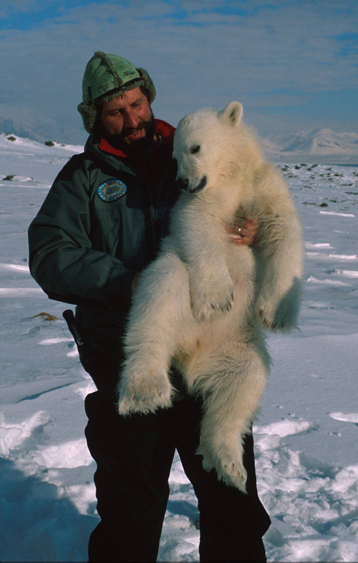

Polar Bears at Risk in a Changing Arctic
If the north continues to warm, polar bears may disappear within the next century, according to a man who has studied them for the last 20 years.
Andrew Derocher is a biology professor at the University of Alberta in Edmonton who visited Fairbanks recently. In a lecture he gave on the UAF campus, Derocher said that the places where the globe is warming fastest are where polar bears live, such as the Beaufort Sea coast north of Alaska.
A warmer north is a bigger threat to polar bears than toxic chemicals or oil development, Derocher said, and sea ice is the reason. Polar bears rely on sea ice, and as the amount of sea ice shrinks with increased warming, so will the world’s numbers of polar bears.
Sea ice is important to polar bears because it is home to their main prey—ringed seals that weigh up to 140 pounds and bearded seals that can reach 750 pounds. Polar bears will also eat beluga whales trapped in confined areas and other animals that overlap with their range of sea ice and arctic coastal areas, but seals are their number one food.
Seals are also dependent on sea ice, and sea ice is shrinking as each year passes, Derocher said. He showed what he regarded as a dependable computer simulation of sea ice extent in the year 2050 if warming continues at the current pace. The ice, which grows each winter to touch the northern coasts of Alaska, Canada, and three other countries, will have retreated northward by 2050, leaving about 250 miles of open ocean between Kaktovik and the North Pole. Though polar bears retreat north with the ice each summer, a forced retreat to the North Pole will probably do them in, Derocher said.
“Polar bears are a continental shelf species,” he said. “They don’t do well over deep water. Deep water isn’t as productive, and there won’t be any bearded seals or walrus calves available up there.
Polar bears could survive on land, and they do in some places, but if shrinking sea ice forces polar bears south, the animals will be intruding on the territory of the brown bear, which is better adapted to eat anything.
“There’s no niche available for the polar bear on land,” Derocher said.
Another problem that already exists is a lack of feeding time for female polar bears in areas like Hudson Bay, where females don’t eat for eight months as they give birth on land and wait for sea ice to return. Ice is forming later in Hudson Bay each year, and studies have shown that plump females often have litters of three cubs, while skinny females have one. Also, because sea ice is like a giant, moving jigsaw puzzle, polar bears have to move around just to stay in the same place. Sea ice drifts faster as it shrinks, requiring polar bears to burn more energy to stay in their preferred habitats.
Today, there are perhaps 25,000 polar bears hunting the sea ice north of Alaska, Canada, Russia, Norway and Denmark. Derocher is familiar with the polar bears of the Norwegian Arctic, the Beaufort Sea north of the Northwest Territories and the bears of western Hudson Bay, near Churchill, Manitoba. Last year, he returned for the first time in two decades to the Beaufort Sea.
“I was pretty shocked in how the ice had changed just in that 20 year period,” he said.
“We could all stop buying SUVs,” he said. “Humans have to realize that we have an impact on the planet.”






